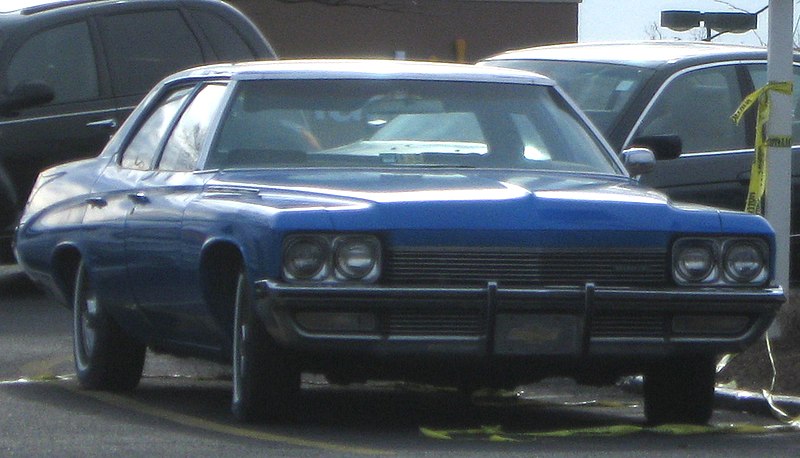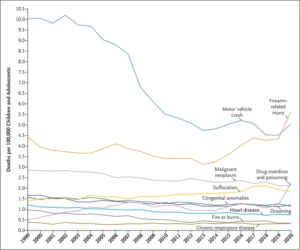Survivorship Bias in Child Passenger Safety

(Last Updated On: July 7, 2023)
Preschoolers need car seats
“When I was in preschool, the journey to school started with me getting into the back seat. No vehicle seat belt or car seat was required back then – I just plopped my 4 year old self onto the seat and we were off. Every day, part of our journey involved stopping at the stop sign in front of the library. One awful day, a passing car didn’t stop. It plowed into us, totaling our car and hurling unrestrained little me into the wheel well. I walked away. We all walked away that day. The stop sign we stopped at every morning is now a traffic light.

Buick LeSabre photo courtesy of Wikimedia Commons
I know now how very lucky we all were that day. There were no airbags in the vehicle and we weren’t wearing the lap only seat belts that were available. Heck, I’m pretty sure that our 1973 Buick LeSabre didn’t even have a crumple zone.

This is how we ride to preschool today!
Despite my family being lucky enough to walk away from that crash back then, I can’t imagine a scenario where I would have done the same – ignored the seat belt and not used a car seat – for my own kids. That’s because times have changed, these devices not only exist, car seats are getting easier to install and use properly all the time.
Best practices for car seats and booster seats weren’t even a topic of conversation back then. And yet, I can’t imagine driving an unrestrained child anywhere today!”
–CSFTL Admin Liz
The norms of the time that led our admin Liz’s family to disregard seat belts and not ever consider purchasing a car seat were just that – the norms of the time. Since that fateful day, car seats, car safety, and even seat belt use have come a long way. More and more people can walk away from crashes that would have been fatal, thanks to these handy devices.
And yet, we hear it all the time in our Facebook group: “Help me convince *insert anyone* that just because they didn’t use car seats doesn’t mean it’s safe for them to drive my child around without one!”
Our focus is on keeping children safe in the vehicle – it isn’t on winning arguments. But we recognize that many people who survived different types of car crashes or other potentially life-threatening events feel that just because they survived, it somehow means that whatever they did was safe. This attitude is called survivorship bias and we’d like to address it here.
Anecdotal Fallacies in Survivorship Bias
We hear these arguments a lot:
“I didn’t use a car seat and I survived!”“My kids wear coats in the car seat and they are fine!”“Oh, my son forward faced at 1 year old and nothing bad happened”
That’s great! We are very happy about those outcomes… but those statements beg quite a few questions, and the main one is: how many severe collisions were the speaker involved in?
These are all examples of anecdotal fallacies. That’s the mindset that since a person was not negatively impacted by a potentially dangerous situation, (as far as they can tell), then no one else will be negatively affected by a similar situation, either.
Dead men don’t tell tales. The children and adults who didn’t survive have no way of disputing the comments made by those who did. It’s a pretty one-sided argument that way, which is unfortunate because safety measures like seat belts, airbags, and child restraints save thousands of lives every year.
A Brief History of Child Passenger Safety
Cars weren’t created with safety as a primary feature. Cars were invented to get people from point A to point B. That’s it. A method of transportation. Vehicle safety and the need for vehicle safety has evolved over time.
Seat Belt History
The first US Patent for a two-point seat belt (also known as a lap-only seat belt) was issued in 1885 and the description was “designed to be applied to the person, and provided with hooks and other attachments for securing the person to a fixed object.” This is a pretty apt definition of a lap-only seat belt – it secures a person to a fixed object (like an automobile). Lap-only seat belts did keep drivers and passengers inside the vehicle but they also led to serious abdominal injuries in high-speed motor vehicle collisions (especially in race car drivers), which prompted Volvo Car Corporation’s chief safety engineer Nils Bohlin to invent and patent the three-point seatbelt (lap/shoulder belt) that we see in modern vehicles in 1959.
Recognizing what a significant safety improvement this lap/shoulder belt was over the original lap-only belt, Volvo made the design available for free, and by 1968 the lap/shoulder belt was legally required on all newly manufactured US vehicles. “At the time of Bohlin’s death in September 2002, Volvo estimated that the seat belt had saved more than one million lives in the four decades since it was introduced” – that works out to over 29,000 lives saved per year with this relatively simple invention.
Car Seat History
Before the 1960s, car seats for safety weren’t even being thought of, since at that time, child seats were only created to help children see out of the window. It was common practice for children to either be held by adults or older siblings or to sit by themselves in the vehicle seat. The first iterations of child safety seats were introduced in 1962 and nine years later in 1971, National Highway Traffic Safety Administration (NHTSA) introduced the first version of the federal motor vehicle standard FMVSS213 that defines requirements for child restraints.
The 1971 version of FMVSS213 regulations did not include crash testing but did require two things: the use of a safety belt and a harness to secure the child. It wasn’t until 1979 that the first state car seat law went into effect (in Tennessee) and by 1985, all states had adopted some version of car seat laws. However, legal doesn’t mean safe and innovation always precedes regulation.
Over the Years
The National Highway Traffic and Safety Administration released a Technical Report in December 1988 titled ‘Lives Saved by Child Restraints from 1982 through 1987.’ It was the first technical report we were able to find from them that addressed child restraint usage. The report included the following statement:
“If all young children used child restraints, more lives could be saved. With 100 percent use, child seats (with the mix of correct and incorrect use during 1982 through 1987) could have saved an estimated: 369 lives in 1982, 380 lives in 1983, 355 lives in 1984, 378 lives in 1985, 405 lives in 1986, and 462 lives in 1987. “

1984 child restraint
Two thousand, three hundred and forty nine children died in motor vehicle collisions during that time whom NHTSA believes could have lived had they used child restraints. Child restraints in the 1980s weren’t much more than devices used to prevent children from crawling around the vehicle. They often resembled a type of seat one would use at the table to ensure the child was unable to escape until they finished their dinner – not something meant to keep them safe in the event of a collision. Yet they did just that, and (from the same report) saved 838 children’s lives between 1982 and 1987.
Here is some notable data from annual NHTSA reports:
1994:
The 0-14 year age group accounted for 7% (2,883) of the 40,676 traffic fatalities in the USWhere restrain use was known, 50% of those children were unrestrainedThe 0-4 year age group accounted for 681 of those fatalities and an estimated 58% (393 children) were unrestrained
2000:
The 0-14 year age group accounted for 6% (2,343) of the 41,821 traffic fatalities in the USWhere restrain use was known, 36% of those children were unrestrainedThe 0-4 year age group accounted for 529 of those fatalities and an estimated 47% (251 children) were unrestrained
2010:
The 0-14 year age group accounted for 4% (1,210) of the 32,885 traffic fatalities in the USWhere restrain use was known, 41% of those children were unrestrainedThe 0-4 year age group accounted for 291 of those fatalities and an estimated 28% (77 children) were unrestrained
2020:
The 0-14 year age group accounted for 3% (1,093) of the 38,824 traffic fatalities in the USWhere restrain use was known, 41% of those children were unrestrainedThe 0-4 year age group accounted for 755 of those fatalities and where restraint use was known, 42% (286 children) were unrestrained (restraint usage was known for 680 fatalities)
Reducing the percentage of child fatalities by four percent over 26 years may not seem like much, but that means that in 2020, 1,553 children’s lives were saved through occupant protection systems that include child restraints.

the New England Journal of Medicine – Leading Causes of Death Among Children and Adolescents in the United States, 1999 through 2020
Today
Despite the fact that the first safety-focused car seat was made over 60 years ago, we still don’t see 100% car seat usage for children. The older the child is, the less likely they are to be in a car seat or booster seat at all.
In 2023, we know a lot more now than we did in the 60s, 70s, and 80s… heck, we know more now than we did even 5-6 years ago. We know that children should not be forward facing before they outgrow their convertible car seat rear facing, and that most 8-10-year-olds still need booster seats. So why don’t we see this in practice? Usually it’s due to people who survived situations that used to be considered safe still believing that these practices are still considered safe today. And that assumption is wrong.
In our Car Seats for the Littles Facebook group(our technical forum where we help parents and caregivers with their car seats) we see survivorship bias pretty often.
Common situations where we see survivorship bias taking priority over facts:
Forward facing before the convertible car seat is outgrown rear facingUsing a booster seat before the child is five years old and the child is still within the height and weight limits of harnessed car seatsDiscontinuing boosters before fitting the adult seat beltUsing aftermarket productsAllowing the child to sit in the front vehicle seat before they are 13 years old when an alternative seating location in the back seat is available
What we can Learn
Technology, innovation, regulations, and laws will all change. The best practices we know today may well become outdated in time. Survivorship bias doesn’t just apply to car seat safety, but to many facets of parenting and life in general.
Ways to Counter Survivorship Bias Arguments
Empathize. Car seats and general vehicle safety standards have evolved over time. The person you’re talking to may not know about this evolution.Educate. Take the time to explain the choices you’re making around child passenger safety.
Admin Liz walked away from that long-ago car crash we mentioned at the start of the article. It would be so easy to assume that because she and her family were lucky on that ill-fated drive to preschool, they’d be lucky on other drives as well. But the evolution in safety standards since that day meant that when Liz had kids of her own, she knew better and was able to keep those kiddos safe in a whole new way. Knowledge is power – learning about new improvements when it comes to safety can only improve things.
References
https://theinventors.org/library/inventors/bl_seat_belts.htm
https://www.history.com/this-day-in-history/three-point-seatbelt-inventor-nils-bohlin-born
https://crashstats.nhtsa.dot.gov/Api/Public/ViewPublication/813285
https://crashstats.nhtsa.dot.gov/Api/Public/ViewPublication/811641
NHTSA: Traffic Safety Facts 2000 – Children
https://crashstats.nhtsa.dot.gov/Api/Public/ViewPublication/807371
https://crashstats.nhtsa.dot.gov/Api/Public/ViewPublication/94F2







